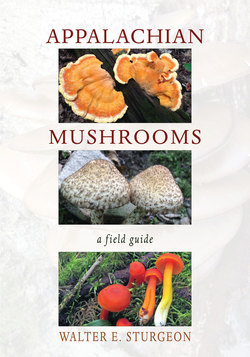Читать книгу Appalachian Mushrooms - Walter E. Sturgeon - Страница 11
ОглавлениеMUSHROOM IDENTIFICATION
THE COLLECTION PROCESS is the first step in mushroom identification. Equipment should include a basket, knife or trowel, and wax or paper bags to keep each collection separate. Large mushrooms can be wrapped in wax paper. Plastic bags are not preferred since they can accelerate the decomposition of the fruit bodies. Do not put more than one kind in each bag. A hand lens is a useful tool for observing small features such as scales or hairs. Care should be taken to collect the whole mushroom, using the knife or trowel to dig to get the bottom of the stem. The base of the stem may have a bulb or remnants of the universal veil, which are important identification features. Note the kinds of trees in the area. Was the mushroom growing on wood, soil, humus, moss, or wood mulch? Those species with specialized habitats—such as those growing on other mushrooms, nut shells, or cones—are usually easily identified.
At home or in the lab, the first step in identifying a mushroom with gills or pores is to determine the color of a spore deposit. This deposit—called a spore print—is made by removing the stem and laying the cap with the gill or the pore side down on a sheet of white paper. Covering the cap with an inverted bowl helps protect it from drying out. After several hours, remove the cover and the mushroom cap. If the mushroom is not sterile, there will be a visible deposit of microscopic spores. The specimen chosen should be mature but not overripe. The color of the spore print is the first step in the identification of a mushroom. Colors range from white to black and include greenish, cream, yellow, ochre, lavender, dark purplish, pink, salmon, and various shades of brown. Many of the common mushrooms have white spores. It is sometimes possible to determine the color of the spores by looking at the mature gills, but a spore print is the only way to be sure.
Identifying a single mushroom is difficult. It is best to have a collection, including young, old, and intermediate stages. Note the presence or absence of a partial veil covering the gills in the button stage. Is there a ring on the stem or flaps of tissue on the cap margin? Is the ring skirt-like or a simple ring? Note the colors of all parts including the cut flesh. Is there a color change when the flesh is exposed? If the mushroom has whitish spores, look for the presence of latex on the cut gills and flesh.
Are the surfaces of the cap and stem bald, hairy, wrinkled, dry, or slimy? Note the gill attachment to the stem. It could be free from the stem, notched, or running down the stem. Stature can be important. Is the stem longer than the cap is wide or vice versa? Note the odor by sniffing the gills, pores, or a bit of the crushed flesh.
Making a spore print can also be useful for some polypores and spine fungi. Many of the other non-gilled species can be identified without making a spore print by observing the features and following the keys.
There are many more species in Appalachia than can be included in a field guide. If a mushroom does not quite fit the description, it likely is not included in this book. Do not try to force your mushroom into a description that does not quite fit. Conversely, consider that young mushrooms can look very different from old ones, and wet caps can look different from dry ones. Read the descriptions closely. Identifying a mushroom from just a picture can be very difficult. Photos often represent mushrooms in pristine or at least in good condition. Mushrooms may look very different owing to age and environmental conditions.
